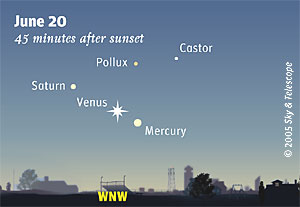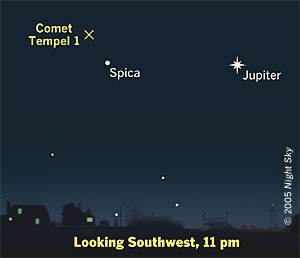June 17, 2005
Contacts:
Alan M. MacRobert, Senior Editor
855-638-5388 x151, [email protected]
Marcy L. McCreary, VP Marketing & Business Dev.
855-638-5388 x143, [email protected]
Note to Editors/Producers: This release is accompanied by publication-quality illustrations and a broadcast-quality video; see details below.
Gaze low to the west into the deepening twilight for the next couple of weeks, and three planets will await your view. One is bright; two are fainter. You can follow them through their celestial gyrations as they shift position day by day.
The direction to look is low in the west-northwest. The brightest light shining there is Venus, the "Evening Star." Dimmer Saturn is closing in on it from the upper left, while Mercury is closing in on it from the lower right. These three planets will form a remarkably tight bunch from June 24th to 27th, appearing close enough together to be covered by your thumb at arm's length.
After that, Saturn gets lower every day and sinks out of sight, while Venus and Mercury remain closely paired into the first week of July. The crescent Moon hangs with Mercury and Venus on July 8th. Meanwhile, the background stars Pollux and Castor add to the scene. Binoculars will enhance the view.
Accompanying this release is a series of daily sky scenes that illustrate what to look for in the fading twilight on any date. They can also be played in sequence as a QuickTime movie to show the dance of the planets throughout this period.
A fourth bright planet is also in evening view, far to the upper left of the group of three. This is Jupiter, shining high in the southwest. Aside from Venus, it's the brightest point of light in the sky. (In fact, some people may confuse it with Venus until they realize they should be looking much lower and to the right for the Evening Star.)
All these planets appear about the same distance away as you watch them in the deepening dusk, but this is an illusion. Mercury is roughly 90 million miles away (its distance changes during the period illustrated); Venus is about 140 million miles away, and Saturn is 930 million miles — about 10 times farther than Mercury. Jupiter is about 500 million miles away.
Such big distances are better expressed by how long it takes light to cross them. Mercury is about 8 light-minutes distant, Venus is about 12 light-minutes away, and Saturn is 85 light-minutes from us. Jupiter is 45 light-minutes distant. By comparison, the stars Pollux and Castor, in the constellation Gemini, are 34 and 52 light-years away, respectively.
NASA's Comet Crash in the Sky
There's another reason to start paying attention to the western dusk. On the night of July 3rd, NASA's Deep Impact probe will slam at 23,000 miles per hour into the icy, mountain-size nucleus of Comet Tempel 1. Nothing of this event will be visible to the unaided eye (contrary to over-optimistic claims), but at least you can see the place in the sky where it happens.
Find Jupiter again high in the southwest. Off to its left, by somewhat more than the width of your fist at arm's length, is the fainter star Spica, in the constellation Virgo. The impact with the comet will happen a couple of finger-widths above Spica.
The crash is set to happen around 10:52 p.m. Pacific Daylight Time July 3rd (1:52 a.m. Eastern Daylight Time on the morning of July 4th). At that time, Jupiter, Spica, and the comet's position will be in good view from the western United States, especially the Southwest.
Deep Impact's 800-pound projectile should blast a crater anywhere from the size of a large house to the size of a stadium in the comet's 9-by-2½-mile nucleus, while instruments aboard the main spacecraft watch from a safe distance. Scientists hope this first-ever comet excavation will provide information about comets' internal composition and structure.
Some of the world's biggest telescopes will also be watching in the following hours, days, and weeks. Countless amateur telescope users will be watching too. But even during and after impact the comet is expected to be faint, and telescope users will need to use a detailed star chart to locate it.
A finder chart showing sufficiently faint stars accompanies this release. Suitable charts also appear in the June 2005 issue of Sky & Telescope, the July-August 2005 issue of Night Sky, and online at SkyandTelescope.com. Anyone who's not already familiar with how to use star charts with a telescope will need to follow the beginner's instructions in the online article.
If your evening sky is clear on July 6th or 7th, there's a much easier way to find Comet Tempel 1 with your telescope. Just center Spica in your lowest-power eyepiece, then let the sky drift by (turn off the scope's tracking motor if it has one). Wait exactly 20 minutes, and Comet Tempel 1 should be in the field of view.
Much more about the Deep Impact mission and its target comet appears in the cover stories of the June 2005 Sky & Telescope.
Sky & Telescope is pleased to make the following illustrations and video available to our colleagues in the news media. Permission is granted for one-time, nonexclusive use in print and broadcast media, as long as appropriate credits (as noted in each caption) are included. Web publication must include a link to SkyandTelescope.com.

Watch Saturn, Venus, and Mercury close in on each other in late June 2005. At month's end they dance through a tight grouping above the sunset horizon. Click on the image to download an animation (537-kilobyte QuickTime movie) showing the planets' positions changing from night to night from late June into early July. Publication-quality versions of individual frames are available for the following dates as 64-kilobyte JPEG images: June 20, June 22, June 24, June 26, June 28, July 8.
Sky & Telescope illustration by Gregg Dinderman.

On the night of July 3–4 and for several evenings immediately afterward, Comet Tempel 1 will be situated in the western sky not far from the bright star Spica. Even after Deep Impact makes its splashy arrival, the comet will likely not be visible to the unaided eye. Instead, try looking in the location marked X with good binoculars or a small telescope. The comet will look like a faint, fuzzy star. Click on the image to get a higher-resolution version suitable for publication or broadcast.
Sky & Telescope diagram by Steven Simpson.

You can find Comet Tempel 1 in binoculars or a telescope by looking near the planet Jupiter and the star Spica, as shown here. Click on the image to download a publication-quality version (256-kilobyte TIFF) by anonymous FTP.
Night Sky illustration by Steven A. Simpson.
Sky Publishing Corp. was founded in 1941 by Charles A. Federer Jr. and Helen Spence Federer, the original editors of Sky & Telescope magazine. The company's headquarters are in Cambridge, Massachusetts, near the Harvard-Smithsonian Center for Astrophysics. In addition to Sky & Telescope and SkyandTelescope.com, the company publishes Night Sky magazine (a bimonthly for beginners with a Web site at NightSkyMag.com), two annuals (Beautiful Universe and SkyWatch), as well as books, star atlases, posters, prints, globes, and other fine astronomy products.
 0
0
Comments
You must be logged in to post a comment.